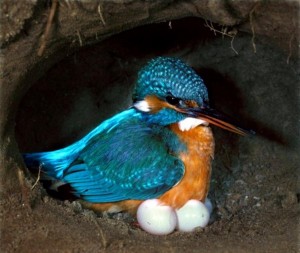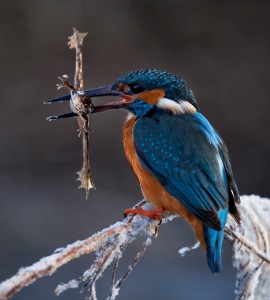Week 57 – 13 August 2017:
Many Mouths, All Well Fed
Advances in science do not always rely on expensive, sophisticated equipment. Sometimes the most interesting findings are the result of simple hard work. A recent publication by Martin and Pavel Čech of Charles University in Prague and the Czech Union for Nature Conservation typify this. The father and son team of Čech and Čech asked a comparatively simple question. How does the rate at which adult Common Kingfishers provide food to their chicks change with the number of chicks in the nest?
The question might be simple, but the answer could be significant. An understanding of the food intake by piscivorous birds like kingfishers, herons and cormorants may have important implications for recreational and commercial angling, stocking rates, and even fish conservation programs. Given that each pair of Common Kingfishers will raise as many as four broods of young per year, each with between four and eight chicks, a lot of fish must be going into a lot of mouths.
Čech and Čech quantified the number and types of fish that Common Kingfishers took from rivers in Central Bohemia and the Highlands Region of the Czech Republic. Rather than attempting to determine kingfisher diet on the basis of video images, which may or may not be reliable, they chose a more direct approach. Common Kingfishers build their nests at the end of tunnels in riverbanks. The pair of investigators altered nest chambers, so that they could gain access from above. This enabled them to monitor the progress of chicks through the breeding season.
Čech and Čech were also able to take from the kingfisher nesting chambers all of undigested fish remains that had been regurgitated by the chicks as pellets. Such pellets are produced by chicks three or four times each day. The researchers washed and sieved these pellets to collect fish bones. These bones were were compared to a reference collection of bones to determine the size and species of fish. Amassing the reference collection, based on 776 individual fish, must have been a monumental task even before analysis of the kingfisher’s diet began.
From six kingfisher nesting cavities, 31,304 bones of 4,722 specimens of 24 fish species were retrieved. Among the most common of these were common dace, gudgeon, bleak and roach. The smallest fish delivered to a chick would have been 0.01 grams, and the largest 16.2 grams. Given that a Common Kingfisher weighs about 50 grams at the time it leaves the nest, the largest of the fish delivered must have been a challenge to consume. On average, each chick ate 37% of its own body mass each day.
From an ecological perspective, one of the most interesting results was that each chick in a larger brood was provisioned just as well as a chick in a much smaller brood. Being one of eight chicks in a nest proved to be no handicap.
When I contacted him, Martin Čech was able to further enlighten me about the challenging lives of Common Kingfishers in Europe. He explained that the bird’s nesting habitat, the bank walls of rivers and reservoirs, is being degraded as a result of the regulation of rivers. A wide assortment of predators are able to sense the nests, presumably by smell. These include otters, American mink, foxes, feral pigs and Norwegian rats. The artificial nests used by Čech and Čech diminish the threat of mammalian predators.
Winter also represents a big problem for Common Kingfishers in Central Europe. Some birds escape winter by flying to warmer climates, but some remain as residents. If the temperatures fall far enough to cover the rivers, then “they are facing death in a few days,” wrote Martin. He went on to say that some kingfishers exploit local up-wellings of warm water. Others resort to capturing strange prey in times of severe weather, as depicted.
Despite all of the challenges that are faced by Common Kingfishers, let’s hope that they continue to earn their name.
Čech, M., and P. Čech. 2017. Effect of brood size on food provisioning rate in Commmon Kingfishers Alcedo atthis. Ardea 105. doi:10.5253/arde.v105i1.a3.
Photo credits: Common Kingfisher on eggs – www.pinterest.com; Common Kingfisher with frog in winter, photographed by and © Pavel Čech.



